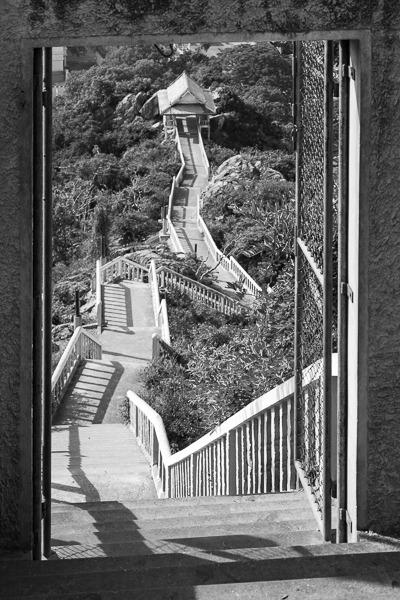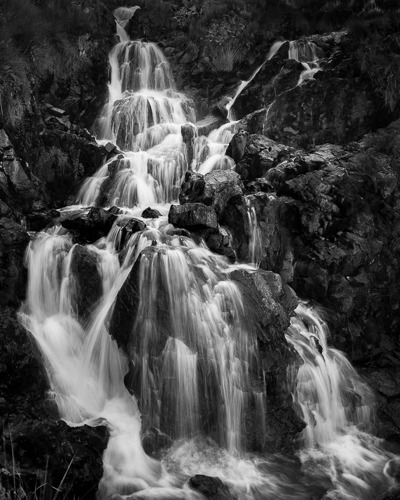Elements of Flow
October 1st, 2019There are at least two elements that influence a viewer’s scan of an image: lines and contrast. Lines are elements of movement, guiding or directing the flow through the image; points of contrast are the elements that provide resting points.
Consider this image of the steps leading down from the Wat Khao Chong Kaeo temple in Prachuap Khiri Khan, Thailand.

(Canon 5DMII, EF24-105 @ 75mm, 1/50s, f/8, ISO 100)
The bright white banisters along the stairs lead the viewer’s gaze from the lower part of the image through the center and up to the small building at the top of the image. At the building the banisters stop and consequently so does our flow. In this image there are real, solid lines that direct our gaze through the image.
Now consider this image of a waterfall in the Cordillera Huayhuash of Peru.

(Canon 5DMII, EF24-105 @ 28mm, 1/6s, f/11, ISO 100)
In this image we find our gaze resting on the small rock in the middle of the waterfall just up and left of the center of the image. There are no strong, hard lines like in the previous example but there are implied lines that are influencing our experience of the image. As our eyes wander about, exploring the textures and contrasts, these implied lines keep bringing our attention back to that central rock.
Some of these lines are strong, short and straight, like the thin and very straight line of water in the upper right, and others are very vague and fractured like the long division between the water and rock that curves from the lower right corner up and left to the center of the image. Many of them work to keep our focus within the image and draw our view into the center.
Here’s one more image, of my grandson at a lake in Missouri.

(Canon Rebel XSi, EF50, 1/750s, f/6.7, ISO 200)
In this image the flow directs our gaze from his face to some point on the shoreline. In this image there are no lines, real or implied. There’s just his intent focus on whatever it is that has caught his interest, but even as an imaginary line it’s enough to add some flow to the image and cause us to scan for whatever it is he’s looking at.
Next time you’re looking through your lens think about the image you’re trying to capture and try to add energy, movement and dynamics into the two dimensional scene with lines, real or implied, that guide the viewers gaze through the image.
